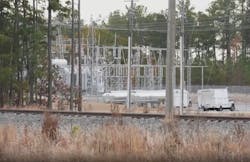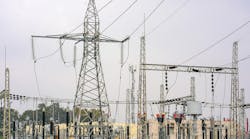Attacks on electrical substations in 3 states raise more questions about grid security
At least three electricity providers in the Pacific Northwest have recently experienced attacks similar to the gunfire that brought down two electrical substations in North Carolina on Saturday and knocked out power to tens of thousands of customers of Duke Energy.
The attacks highlight growing concerns about the vulnerability of the nation’s electric grid to vandalism and terrorist attacks amidst increasing political extremism. They also raise questions about what, if anything, can be done to protect a far-flung and often remote network of thousands of substations that sometimes have little more security than the fencing surrounding them.
Utilities are typically tight-lipped about such incidents so as not to encourage copycats, but the Bonneville Power Administration, Portland General Electric and Puget Sound Energy confirmed recent deliberate physical attacks on substations in Clackamas County and in western Washington. All are working with the FBI, which did not return a call for comment. It’s unclear if there is a connection between any of the incidents or whether any suspects had been identified.
BPA spokesperson Doug Johnson said vandalism to the power marketing agency’s substation took place on Thanksgiving and did not result in a power outage.
“Someone clearly wanted to damage equipment and, possibly, cause a power outage,” John Lahti, transmission vice president of field services, said in a news release. “The damage and associated cleanup will cost Northwest ratepayers hundreds of thousands of dollars. We were fortunate to avoid any power supply disruption, which would have jeopardized public safety, increased financial damages and presented challenges to the community on a holiday.”
A security specialist at BPA sent a memo to law enforcement officials describing the November incident at its substation and asking for additional vigilance and patrols at one of its critical substations. The memo, first reported by Oregon Public Broadcasting, said “two intruders cut into the fence and used firearms to shoot up and disable numerous pieces of equipment and cause significant damage.”
It also described recent attacks on substations in western Washington without clarifying if those were the facilities operated by Puget Sound Energy. The memo said the attacks included “setting the control houses on fire, forced entry and sabotage of intricate electrical control systems, causing short circuits by tossing chains across the overhead buswork, and ballistic attack with small caliber firearms.”
The memo said there has been a significant uptick of break-ins by intruders looking to steal copper wire or other materials, “but now we are dealing with quickly escalating incidents of sabotage. Online extremist groups across the political spectrum are not only calling for attacking these types of sites, but also spelling out in detail how to do it.”
BPA asked that the name of the memo’s author be kept confidential.
PGE spokesperson Melissa Havel did not provide additional detail about the attack on its Clackamas County substation in late November. She said in an email that the utility continually assesses the physical security of its substations to prioritize security upgrades, with a focus on evaluating the potential impacts to customers. It says its fencing meets all federal standards where applicable and it seeks to surpass state standards.
The attacks on Puget Sound Energy’s two substations occurred in late November, Gerald Tracy, a spokesperson for the utility, said in an email. Both were reported to local law enforcement and the FBI.
“Both cases appear to be isolated and not related to incidents recently reported by other utilities,” he said. “There is no indication that these vandalism attempts indicate a greater risk to our operations and we have extensive measures to monitor, protect and minimize the risk to our equipment and infrastructure. "
Vandalism and theft at such facilities is fairly routine, though federal authorities warned utilities earlier this year that the threat had been amplified by the rise of political extremism and that groups had developed specific plans to attack the electricity infrastructure since at least 2020.
The problem is clearly longer standing than that. In 2013, 150 rounds fired from an assault rifle took down 17 transformers at a substation in Silicon Valley. That incident prompted federal regulators to adopt new reliability standards to address power grid security, including the physical security of transmission lines, substations and associated control centers.
But Tony Sleva, an industry consultant with Prescient Transmission Systems in Hillsboro, said those standards only apply to large high-voltage substations. There are no such federal standards for neighborhood substations, he said.
Kandi Young, a spokesperson for the Oregon Public Utility Commission, said in an email that no decisions have been made by the PUC about next actions to address these types of incidents.
“The PUC has not requested any changes in the readiness of Oregon energy utilities for these types of incidents, although their public statements indicate their vigilance on such matters,” she said.
Substations contain transformers and other equipment that regulate the flow of power over the high-voltage grid and step down the voltage of electricity to deliver it over local distribution systems to homes and businesses. Transformers can be an easy target. Large ones are the size of a U-Haul truck, cost more than $1 million, and utilities often only have a few spares.
Moreover, the sheer geographic scope of the problem makes it difficult to address. Bonneville, which operates three quarters of the region’s high-voltage grid, has about 300 substations scattered across the Northwest. Meanwhile, the location and other information about utility substations is easily accessible on the internet.
“Google Maps provides satellite views of every substation,” Sleva said in a recent blog post on the subject. “Additionally, a potential saboteur need only google ‘large power transformer’ to learn everything they want to know about large power transformers in less than a day.”
Sleva said the incidents often involve gunfire that penetrates the fairly thin radiator walls surrounding a transformer, causing oil to leak out and the transformer to overheat and fail.
Utilities typically build redundancy into their networks to reroute power when a transformer goes down. But Sleva said regional substations, particularly critical assets, need to be hardened against such threats, including more robust perimeters, better threat detection and the installation of masonry walls that can withstand small arms fire.
The economics of such measures are difficult to quantify, and Bob Jenks, executive director of the Oregon Citizens’ Utility Board, said utilities might face opposition from local residents who don’t want an impenetrable bunker established in the middle of their neighborhoods.
“I don’t know the answer of what they can do to harden them,” he said. “There are a lot of them in the distribution system. Putting security there is difficult, but you can build the system so you’re not vulnerable to a single station going out and having tens of thousands people out of service.”
BPA is asking anyone with information related to the November incident or other threats to electric infrastructure to contact the FBI at 503-224-4181 or BPA’s Crime Witness hotline at 800-437-2744.




